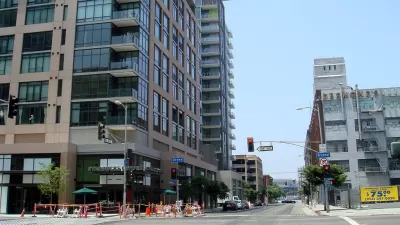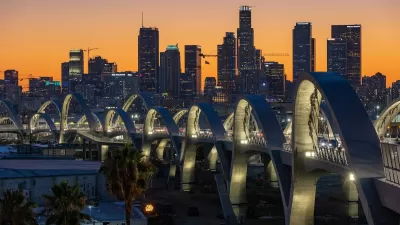Chinese developers are pouring money into high-rise housing projects in Los Angeles. But will these be pieds-a-terre for absent buyers? And how are developers dealing with the American regulatory environment?

To a large extent, Asian money is driving much of the current development in Downtown L.A. Developed by Korea's Hanjin Group, the Wilshire Grand Center is currently the tallest building on the West Coast. And in recent years, David Pierson writes, "Chinese developers such as Greenland, Oceanwide and Shenzhen Hazens are pouring billions into the neighborhood, adding thousands of new residential units in soaring skyscrapers that will fundamentally change the city's skyline."
"'When all these megaprojects are finished, they’re going to have to reshoot the postcard picture of downtown L.A.,' said Mark Tarczynski, executive vice president for Colliers International's L.A. office."
Flush from the go-go building climate in cities like Shanghai and those surrounding the Pearl River Delta, Chinese developers have had to get used to a safer, more regulated approach in the United States.
In addition to the usual anti-development arguments, a concern on the American side is that Chinese developers "can rely on both local and Chinese-based home buyers to scoop up their condos. [...] Some downtown L.A. residents have expressed concern that Chinese investors will leave their properties empty — a phenomenon common in China and antithetical to the dense urban neighborhood many local boosters have long championed."
Taxes are also structured differently between both countries. "In China, there's no real property tax, so local governments rely on land sales for more than a quarter of their revenue. That gives them every incentive to expedite real estate development."
FULL STORY: They built towering new cities in China. Now they're trying it in downtown L.A.

Planetizen Federal Action Tracker
A weekly monitor of how Trump’s orders and actions are impacting planners and planning in America.

Chicago’s Ghost Rails
Just beneath the surface of the modern city lie the remnants of its expansive early 20th-century streetcar system.

San Antonio and Austin are Fusing Into one Massive Megaregion
The region spanning the two central Texas cities is growing fast, posing challenges for local infrastructure and water supplies.

Since Zion's Shuttles Went Electric “The Smog is Gone”
Visitors to Zion National Park can enjoy the canyon via the nation’s first fully electric park shuttle system.

Trump Distributing DOT Safety Funds at 1/10 Rate of Biden
Funds for Safe Streets and other transportation safety and equity programs are being held up by administrative reviews and conflicts with the Trump administration’s priorities.

German Cities Subsidize Taxis for Women Amid Wave of Violence
Free or low-cost taxi rides can help women navigate cities more safely, but critics say the programs don't address the root causes of violence against women.
Urban Design for Planners 1: Software Tools
This six-course series explores essential urban design concepts using open source software and equips planners with the tools they need to participate fully in the urban design process.
Planning for Universal Design
Learn the tools for implementing Universal Design in planning regulations.
planning NEXT
Appalachian Highlands Housing Partners
Mpact (founded as Rail~Volution)
City of Camden Redevelopment Agency
City of Astoria
City of Portland
City of Laramie





























